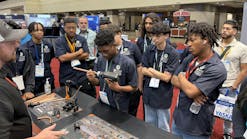ORLANDO, FLA. — A packed room greeted John Siegenthaler, P.E. and principle for Appropriate Designs as he began his free educational session, "Reducing Water Temperature in Existing Hydronic Heating Systems," on Tuesday, Feb. 4th, the second full day of AHR Expo 2020.
As high-efficiency boilers and renewable energy heat sources become more prevalent there is an increasing need for compatible hydronic delivery systems. Based on the best data on performance characteristics, lower water temperatures lead to better performing systems. Most legacy systems are "over-boilered," with high-temperature distribution systems that limit the potential of these contemporary heat sources. And why?
- Fossil fuels used to be relatively cheap
- Higher temperatures meant fewer, smaller emitters
- Using 2,000ºF combustion temperatures to create 200ºF water was commonplace
But now, solar, geothermal, water-to-water heat pumps, water-to-air heat pumps, (not to mention mod-con boilers and biomass boilers) all offer high efficiency with lower emissions, although at lower temperatures. Also, the lower the usable temperature of thermal storage, the longer the boiler on/off cycle becomes—longer cycles also yield higher efficiency and lower emissions.
The point of the session was to present techniques to evaluate existing systems for potential operation at significantly lower water temperatures, suggest strategies for retrofitting existing applications, and to illustrate with practical examples.
Two Main Approaches
There are two main approaches to reducing temperatures in existing systems. First, to create a better building envelope, and second, to add heat emitters to the system (such as panel radiators, baseboard, fan coils etc.), or to use some combination of both approaches.
Before beginning either approach, it is important to understand what the load on a design will be over the course of a year; to understand how long and how often a system may have to operate at maximum capacity in order to ensure occupant comfort.
For adding heat emitters (in the example, he used classical fin-tube-style heaters) Siegenthaler broke the process down into five stages:
- Perform a heat load calculation
- Determine the existing amount of existing fin tubes in the system
- Find the new lower water temperature required (he remarked that 120ºF works for a good many applications)
- Estimate the new average circuit temperature
- Find the new average circuit temperature on a historical axis
The calculations may deliver some perplexing results. One example he gave would have had the contractor adding 154 ft. of baseboard to a house that already had 120 ft. In such a case the solution might be to use high-output baseboard instead, or perhaps to add other types of emitters to the system, such as panel radiators. Siegenthaler told his audience to always keep in mind: where am I going to put my extra emitters, where will they fit, and how will I zone the final application?
He also told his audience to keep the principles of thermodynamics in mind at all times:
- The heat output of any emitter drops as the temperature of the supply water drops
- There is always some output provided by the supply water, so long as it is above room temperature
- There is always a trade-off between the total surface area of the heat emitters in a system and the supply water temperature required to meet the heating load
As other pieces of practical advice, he told his listeners to take advantage of outdoor reset whenever possible. Also, be careful with fan coils, as they can sometimes create drafts.
Thermal Equilibrium
Systems always find their own balance between input and output. Most of our control schemes are just different ways of interfering with thermal equilibrium.
Changes to flow rates can cause non-linear changes in heat output. Higher flow rate = higher heat transfer (not to mention noise, corrosion, erosion and increased power cost for the pump). And regrettably, most legacy systems in the U.S. are not just "over-boilered," they are "over-pumped" as well. Who, Siegenthaler asked, hasn't seen a home mechanical room with an entire bank of circulators?
He spoke to the advantages of parallel circuits over series circuits, and illustrated with diagrams. Parallel piping eliminates sequential temperature drop that you find at the end of a long series circuit. Also, parallel piping lends itself to zoning, with all the increase flexibility and efficiency that allows for. He then discussed zoning using thermostatic radiator valves, and zoning using manifold valve actuators.
Another tip: if you are going to retrofit a system for lower temperatures, you may need some form of boiler protection due to condensate. Sustained flue gas condensation will definitely cause corrosion.
Siegenthaler then opened the session up for questions. He closed by saying that much of his session—including many of the diagrams he used in the course of his presentation—could be found in the July, 2019 issue of Idronics, the journal of design innovation for plumbing and heating professionals, published by Caleffi.









